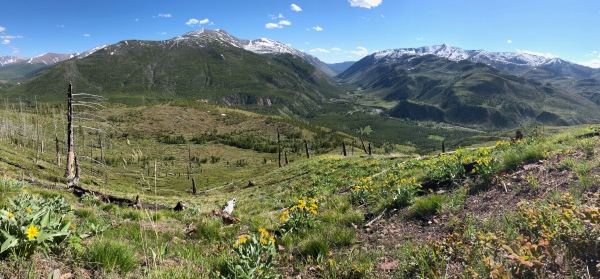Featured Photo: The view from a 14-mile hike in the Scapegoat Wilderness.
One month ago I left Connecticut and began the long drive out to Montana.
Two years of graduate school at Yale F&ES flew by and I found myself preparing for my first “real” job — a seasonal forestry position with the Bureau of Land Management (BLM) in Butte, Montana. Butte was a town I knew nothing about, in a state I knew little about, in a region of the country I had only traveled to a handful of times. When I found myself applying for forestry jobs back in January, I was drawn to Montana because it felt like one of the last truly wild places in the continental U.S. Although I enjoyed my time in New Haven, I was ready to leave the Northeastern megalopolis — and more than ready to leave the Ivy League scene. After five days of driving with my mother and sister, I arrived in Butte. It is the farthest I’ve ever lived from my hometown in southern New Jersey. I’m still getting used to it.
I moved into my apartment on a Saturday and began working the next Tuesday. I was both nervous and excited to start. Ever since my winter internship with the BLM in central California, I have had a desire to manage public lands. The interplay between the public and the vast network of land in the West fascinates me. My field office manages 1.4 million acres of federal land, 100,000 of which are forested. Most of my field work occurs on small, fragmented parcels; something I grew accustomed to back East.
So far I have treated Douglas-fir trees with Methylcyclohexane (MCH — a chemical which repels Douglas-fir beetles) and “cruised” timber. Timber cruising consists of measuring an individual tree’s height, diameter, and percentage of defect to assess the monetary value of a stand of trees. When administering timber sales to the public, it is our job to get the best value for the government. This isn’t difficult: compared to trees that grow in the moist Pacific Northwest, the timber in the Northern Rockies region has a pretty low value. The Douglas-fir forests here seldom reach 100 feet tall. (This isn’t to say the forests of the region have a lower ecological — or ecosystem service — value. That’s a different conversation entirely.)
I have enjoyed the variety of tasks, training opportunities, and people I have met in the area so far. However, I will miss the Northeastern forest that I grew to love over the past 23 years. The ecological, societal, and political complexities of the Northeast do not exist in this area of the country. Or rather, the West has its own set of complexities that I am just beginning to discover.
I feel torn between the comforting familiarity of my old home and the endless possibilities of my new one. At my field sites in southwestern Montana, I am amazed that I can turn 360° and not see a single building — it’s the same feeling I have when I tilt my head back to the stars and consider the vastness of the universe. There are so many places to explore during my time off and I know I’ll never be able to see them all.
But there are days when the Northeast and its forests still call to me. I experienced many small miracles during my time as a forestry student: making eye contact with a barred owl in an Atlantic white cedar swamp, watching fire transform an oak-pine forest, and stumbling across a 300+ year-old white pine in the Yale Myers Forest as the light struck it just right, to name a few. I have no doubt I’ll return to the Northeast one day, whether it’s to work or to play.
I’m not sure what my future holds, but for now I’m content to be surrounded by mountains. On my commute to work, I head towards the Highland range and have the pleasure of watching early-morning fog roll over the snow-capped peaks. It hasn’t ceased to amaze me yet.


